The Mast Wreck
– abstract of the field report
by Torleif Nilsson
Five kilometres east of Gamla Oxelöund at the Bråviken Bay, Swedish East Coast, there
is a remarkable wreck on ca 30 m depth. The wreck site is in a military area where no anchoring or
diving is permitted to the public. The wreck was discovered by the author during a 1992-94 wreck
survey project.
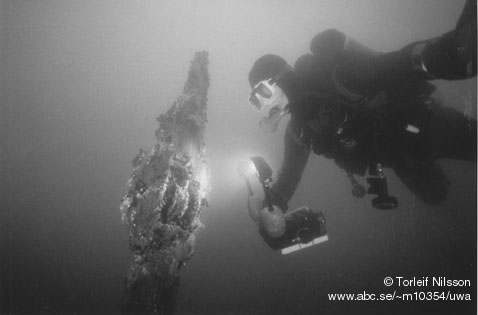
Diver at the top of the standing mast. Note the pulley block still
in position. Photo: Torleif Nilsson.
Unique wreck in the Oxelö archipelago
Even by the high standards of preservation in the Baltic Sea, this wreck is unique in several
aspects. This 17 m long and 5 m wide carvel-built ship stands deeply embedded in the bottom sediment
with no apparent list and seems to be totally untouched since its sinking about 250 years ago. The ship
was two-masted and the main mast is still standing in its full length. On the badly worn deck, there
are several fallen-down rig details, near their original locations. Most of the ship’ interior is
covered by mud, but in the stern section, clay pipes, wine bottles and other domestic items have been
observed.
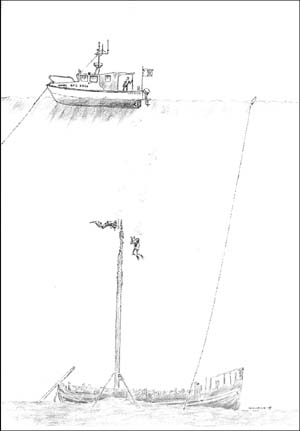
The Mast wreck offers unique opportunities to provide detailed knowledge about shipbuilding
and life onboard an 18th century merchant ship. After the sinking, the ship seems to have
landed almost undamaged on the sea bottom. It is not unlikely that the complete rigging remained more
or less intact for some time, before it rotted away, and the rigging fell straight down on the deck.
The typical Baltic wreckfind has either been smashed at the sinking or damaged later by the forces
of nature or human activity. Many wooden wrecks in the Baltic Sea look more like piles of planks, where
the parts often have been stirred around.
In this case we have instead a wreck that seems to be more or less untouched and where most of its
information is preserved. This is manifested by the standing main mast. Indeed it is worn by time and
several parts have fallen off, but this process has been very gentle. All loose parts remain close to
their original locations.
Already at the first dive in 1994, it was obvious that this wreck needed an immediate investigation.
It was well preserved but at the same time looked very fragile. It seemed to approach a stage of
accelerating collapse.
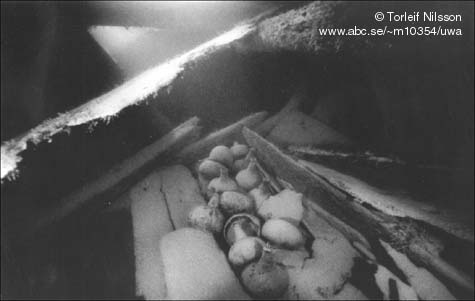
At the stern we located several 18th century wine
bottles. Photo: Torleif Nilsson.
Computer generated models
During 1994-96 extensive video and photo documentation was made as well as measuring of the wreck.
From this data a three-dimensional model was created using the CAD programs Pro/Engineer and
Pro/Mechanica. Based on the CAD model and the video footage, the skilled artist Göran Ullrich made
several accurate images. These images have been a great aid, considering the limited visibility at the
actual site. The drawings are quite detailed, but still preliminary. Several measurements may change
during the course of investigation.
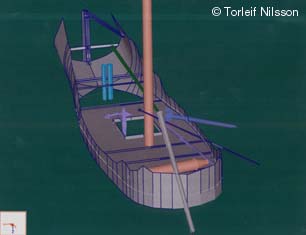
A simplified 3D CAD model, made from measurements as well as video and
photos. By Torleif Nilsson.
1997 fieldwork
During 1997 a permit was given to take samples, for dating the ship. Several wood
samples, pine and oak, were taken for dendrochronology analysis. One glass bottle was brought up from
the group of 13 bottles that lay openly in the stern section. The initially planned probing of the hold
was cancelled following soundings with a thin rod. This indicated that the content of the hold was too
compact to penetrate.
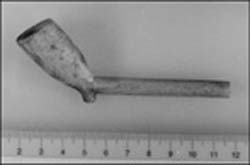
Clay pipe salvaged in 1997 for dating analysis. Photo: SSHM.
Analysis
The dendro analysis has been made by Alf Bråthen, bottle treatment and conservation by Ingrid Hall
Roth (Vasa Museum), bottle analysis by Lars Westergren, and clay pipe analysis by Arne Åkerhagen. They
have all helped the project by doing this free of charge. The analyses suggest that the ship was built
and sank during the first half of the 18th century.
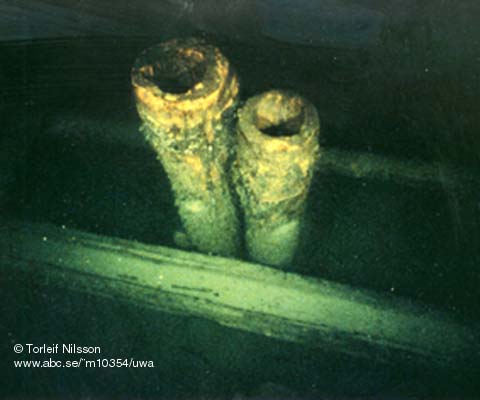
Just aft of the hold two pumps are sticking up. Photo: Torleif
Nilsson.
1998 fieldwork
During the summer of 1998 the documentation continued. Also, the main mast was braced and stabilised
with new rope. This was important not only for the wreck but also for the divers’ safety. A permit was
also given to salvage the remaining visible bottles, since they are fragile and at risk of being
crushed by future collapsing parts of the ship.
Future work
There is no lack of things to do. But presently, the main task is trying to finance future
investigations, as well as the cleaning, conservation and analysis of the items already salvaged. One
of the remaining questions is the cargo. Is it possible to tell without excavating the entire hold? Is
there a way to measure the shape of the lower hull which is embedded in the seabottom?
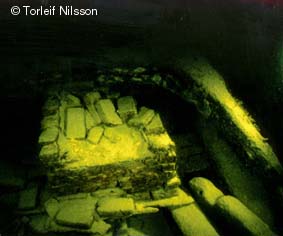
In the stern, where the living quarters were, remains of the galley
can be seen. Photo: Torleif Nilsson.
The Mast Wreck Association
This association was founded in 1997 as a means to find sponsors for the further work. So far,
support has been given by the cities of Nyköping, Trosa and Oxelösund, as well as the county of
Södermanland. We have also been given generous help by Crimson AB, Södermanlands Nyheter, Södermanland
County Museum, SSAB, Fastighetsbolaget Nötknäpparen i Nyköping, Sandvik Handtools AB, Sjöfartsverket,
and Oxelösunds hamn AB.
Torleif Nilsson
abstract of the original report in Swedish,
translated by Per Åkesson, Feb '99
Sonograms
Sonogram 1 (bow upwards) and
sonogram 2 (stern upwards) by
Sture Hultquist. |